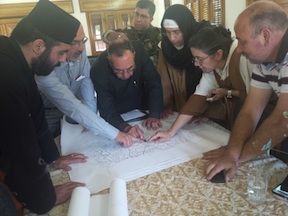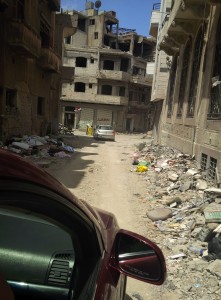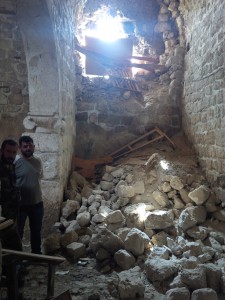
Church representatives and municipal officials discuss the reconstruction of the old city of Homs. photo: Paul Larudee
Jun 16, 2014, Paul Larudee, Dissident Voice
For three years, most residents of the old city in the center of Homs had not seen their homes, shops, churches and mosque. Homs was one of the first cities where armed fighters decided to take on the Syrian army, and those fighters named it “the capital of the revolution”.
That revolution ended in May, 2014 for the fighters in Homs, when they negotiated a retreat from the old city. Starving and running low on ammunition, they accepted the government offer to remove themselves to a different front, taking only their light arms. Some of the fighters gave up entirely, putting their trust in the government amnesty.

Homs old city after some of the debris has been cleared
This allowed weary Homsi citizens to assess the damage and think about recovery of their beloved and historic central district. They didn’t waste any time. By good fortune and good contacts I found myself a fly on the wall at a meeting of Christian community leaders and municipal officials, discussing reconstruction less than a month after the district had been liberated and only two days after the national presidential elections.
Spread out on the table were five blueprint-size maps of the old city, each showing different details. For several hours, they discussed reconstruction plans down to the individual buildings, preservation of the original character, the preferences of the property owners, financing by public and private foundations, interface with Muslim and other community and government leaders and many other considerations.
How did they do all this preparation in a matter of weeks? The next day we went to the old city and surveyed the destruction. I found myself in the car of a man who was entering the destroyed area for the first time. It was clearly difficult to witness. There were many beautiful churches with shattered frescoes, mosaics and icons to rebuild. One was the ancient Church of Mother Mary, built in 59 AD and considered the first Christian Church in existence. However, the most precious losses were to the lives of the people who called it home, including the beloved Father Frans van der Lugt, assassinated only a week before the fighters left.

Destruction of historic sites in Maaloula
Of course, Homs is not the only place that is rebuilding. I also happened to be briefly present for discussion of restoration in the recaptured pilgrimage town of Maaloula, where Aramaic, the language of biblical times, is still spoken. In addition, I visited the recently recaptured Qalamoun region along the Lebanese border. Residents are gradually returning, and by some miracle some communities never left.
Most recently, the Armenian village of Kassab near the Turkish border north of Latakia was retaken by the Syrian army after being overrun by fighters in March, 2014. Many of the residents returned the next day. What these and similar stories have in common are the determination of Syrians to recover and rebuild their communities as soon as government authority can be reestablished.
Of course, government authority is not universally applauded in Syria, and many Syrians have grievances against that authority. However, it appears to be the only force in Syria that is at present capable of bringing some semblance of normal life to its people. Accordingly, the government is adding to its already clear support amongst most Syrians, who appear to have placed bread and butter issues above reform, while maintaining their concern for both.
• All photos by Paul Larudee
River to Sea
 Uprooted Palestinian
Uprooted Palestinian 
The views expressed in this article are the sole responsibility of the author and do not necessarily reflect those of the Blog!
